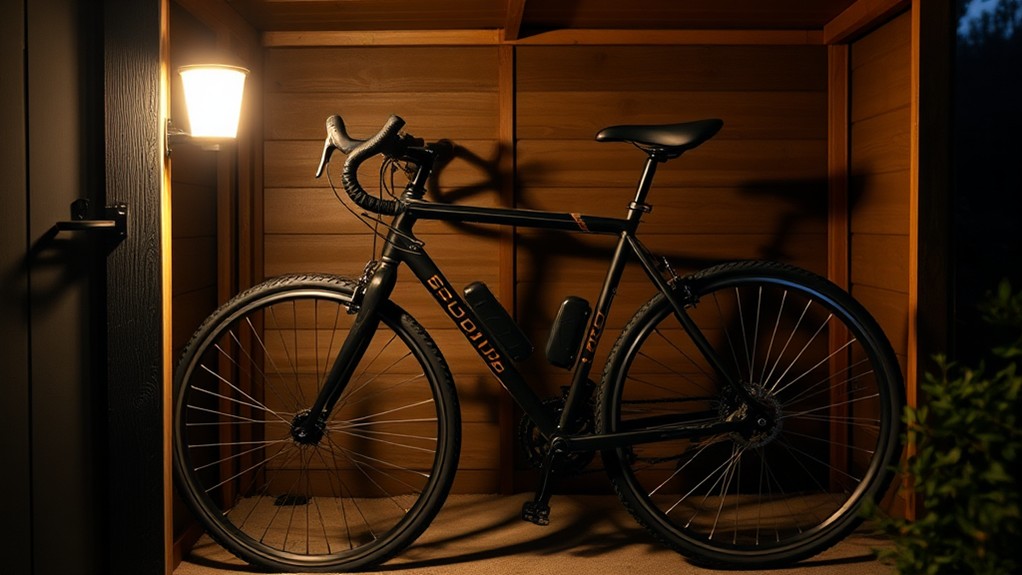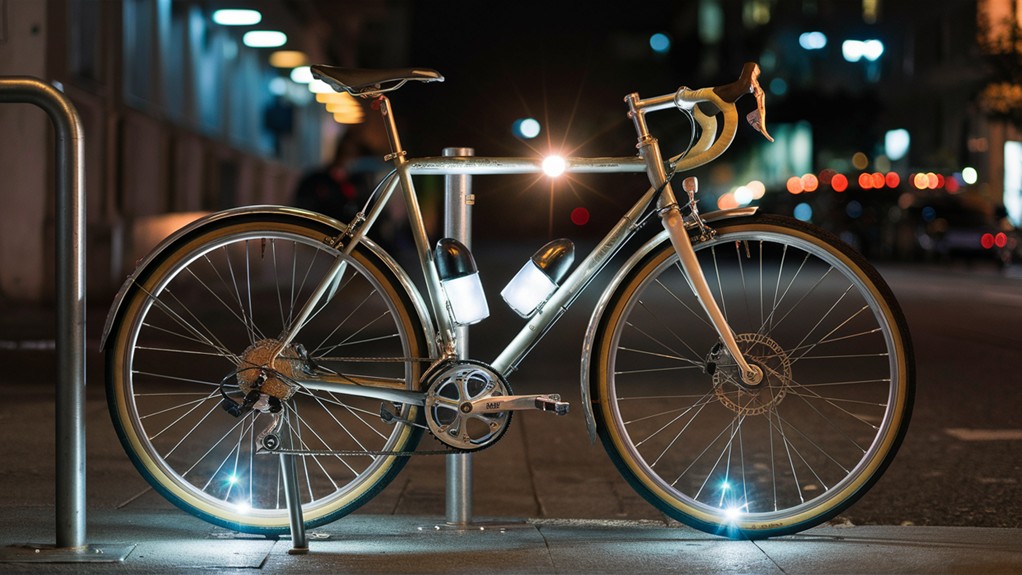To protect your bike from theft, it is crucial to understand the risks and take proactive measures, starting with investing in strong security gear and effective lighting, which can reduce the likelihood of your bike being targeted by up to 25%. When choosing bike locks, allocate around 10% of your bike's value for a high-quality lock, such as a D-lock or chain lock with a Gold rating from Sold Secure. For lighting, opt for LED lights with motion sensors and durable weather-resistant designs. By combining these measures, you'll be well on your way to safeguarding your bike – and there's more to investigate in securing your valuable asset.
Understanding Bike Security Risks
In relation to bike security, you're likely no stranger to the risks. Bike theft is a prevalent issue, with theft statistics showing that a bike is stolen every 7 minutes in the UK. In England and Wales alone, approximately 290,000 bikes were reported stolen in 2017. However, it's important to note that many thefts go unreported, suggesting the actual number is considerably higher.
Understanding the scope of bike theft is vital for developing security awareness. Key facts to take into account include:
- Half of bike thefts occur at homes, emphasizing the need for secure indoor storage and locking practices.
- High-value bikes, especially those worth over $200, are prime targets for thieves, requiring stronger security protocols.
To alleviate these risks, it's important to be aware of your surroundings and take proactive measures. Parking in well-lit, monitored areas and using strong locks can considerably reduce the risk of theft.
Choosing the Right Bike Locks
When it comes to choosing the right bike lock, there are several factors to take into account, including lock materials and lock pricing. Your bike's security relies heavily on the lock you choose, so selecting the right one can greatly reduce the risk of theft.
A general rule of thumb is to budget around 10% of your bike's value for a lock, such as £50 for a £500 bike.
D-locks (U-locks) and chain locks are recommended for their high resistance to cutting. D-locks offer maximum security, while chain locks provide versatility and strength, making them ideal for securing bikes in different environments.
Reflect on the following when selecting a lock:
- Opt for Gold-rated locks from the Sold Secure scheme, which provide maximum security and may be required by insurance providers for coverage
- Avoid using cable locks as primary security devices because of their lower security ratings; they can serve as backup locks to secure wheels or components
- Always use a lock, even for short stops, and employ effective locking techniques by securing both the frame and wheels to a solid object to minimize theft risk
Effective Lighting for Bike Safety

LED lights offer numerous benefits for bike safety, including increased visibility for cyclists during night rides and improved safety of parking areas.
Some key considerations when selecting lighting for bike safety include:
- Brightness: Choose lights that are sufficiently bright to eliminate hiding spots and make it harder for thieves to approach unnoticed.
- Motion sensors: Install motion-activated lights to deter potential thieves and conserve energy.
- Durability: Select lights that are weather-resistant and can withstand different environmental conditions.
Additional Security Measures
While effective lighting plays a significant role in deterring bike thieves, it's just one piece of the complete security puzzle. To further protect your bike, consider implementing supplementary security measures that complement your lighting setup.
Combating Theft with Technology
Alarm systems can be an effective deterrent against bike thieves. These systems can be integrated with your bike's lock or installed as a standalone device. When triggered, they emit a loud noise, drawing attention to the attempted theft.
Enhancing Visibility with Security Cameras
Security cameras can likewise be used to monitor your bike's surroundings. Installing cameras in areas where you frequently park your bike can help deter thieves, as they'll be less likely to target a bike under surveillance. Furthermore, if your bike is stolen, the footage can be used to aid in its recovery.
Supplementary Security Tips
To optimize your bike's security, consider the following:
- Use a combination of different lock types, such as a D-lock and a chain lock.
- Regularly maintain and check your locks to guarantee their reliability and effectiveness.
Preventing Bike Theft at Home

Protecting your bike at home is just as crucial as securing it in public. As a bike owner, you must take necessary precautions to prevent theft, especially considering that half of bike thefts occur at homes. Secure indoor storage is critical, but simply storing your bike indoors is not always sufficient against determined thieves.
To guarantee effective home storage and theft prevention, consider the following measures:
| Security Measures | Description |
|---|---|
| Ground Anchors | Install in your shed or garage to provide an additional layer of security |
| Locks and Chains | Use heavy-duty locks and secure your bikes to heavy, immovable objects |
| Secure Sheds/Storage | Confirm solid doors, good locks, and ideally, no windows or blacked-out windows |
| Regular Maintenance | Check and maintain your locks and storage systems regularly to verify effectiveness |
Responding to Bike Theft Incidents
If your bike does get stolen, it's crucial to act quickly. The emotional impact of bike theft can be significant, but taking immediate action can help minimize the damage.
Start by contacting local law enforcement and providing as much detail as possible about your bike, including the frame number, make, model, and any distinguishing features.
Here are some key steps to take when responding to a bike theft incident:
- Report the theft to local law enforcement, providing detailed information to aid in recovery.
- Document the theft thoroughly by taking photographs and recording serial numbers or registration details.
- Notify your insurance provider and update the status of your bike on the cycle registration database.
- Utilize social media and local forums to share details about the stolen bike, increasing community awareness and improving the chances of recovery.
Frequently Asked Questions
What Are the Mandatory Bike Lights?
When you ride at night, you're required to have a white front bike light visible from 150 meters and a red rear light visible from 100 meters for night riding safety and compliance.
Do Police Still Stamp Bikes?
When taking security measures against bike theft, you'll find that yes, police still stamp bikes with unique IDs, making them less appealing to thieves and increasing the chances of recovery if your bike is stolen.
Does a Bikeregister Work?
You're wondering if BikeRegister works. It does, by creating a national database of registered bikes, aiding theft prevention through quick flagging of stolen bikes and verification of ownership, increasing recovery chances and deterring theft.
How to Get Your Bike Marked?
To get your bike marked, you'll find approved security marking products on the Secured by Design website. Use these to mark your bike and consider adding security stickers as a visible deterrent to thieves.
